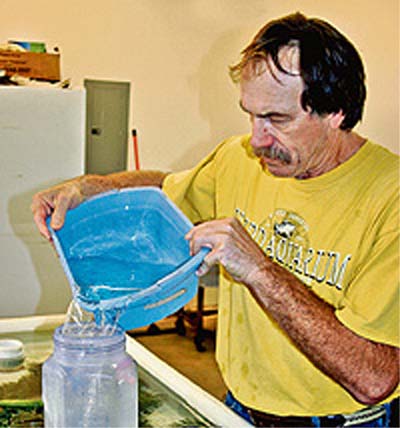
While much of the aquaculture industry uses huge ponds to grow fish, Serge Birk employs what he calls a "semi-intensive system" involving dozens of small tanks and aquariums that are meticulously filtered and closely monitored. Birk asserts he uses about 30 percent of the water that a typical operation uses while providing the crayfish with the nutrients, pristine habitat and breeding controls necessary for them to grow to premium size - about 10 inches long - a feat he said has been virtually impossible to achieve in captivity. The result is a fish that is a popular fixture at several restaurants and has been featured in an Australian-themed dinner at Julia's Kitchen at Copia in Napa, a restaurant named for culinary legend Julia Child. In an age when land and water resources are becoming increasingly limited, Birk is convinced that such efficiency is the wave of the future. "This is going to be the next big deal in aquaculture," Birk said. "In my opinion, this particular product is so superior that our only obstacle is being able to expand enough to accommodate them."
Philippines RPCV Serge Birk raises crayfish indoors
Couple raises crayfish indoors
Fish farmers use low-water practices, semi-intensive system
Tim Hearden
Capital Press
Caption: Serge Birk, co-owner of Redclaw Lobster Farm in Red Bluff, pours angelfish fry back into a container after counting them and checking to see if they were swimming. Angelfish are among several types of tropical fish raised at the farm.
For fish farmer Serge Birk, conserving water doesn't mean skimping on the quality of his product.
Birk, whose Redclaw Lobster farm in Red Bluff is California's only licensed grower of Australian red claw crayfish, says his methods actually enhance the quality of his fish.
Birk and his wife, Beth, grow thousands of the crustaceans in their nondescript greenhouse and lab on the edge of town. They sell the live fish to restaurants throughout Northern California. They also grow and sell "toy" fish such as koi and angelfish.
While much of the aquaculture industry uses huge ponds to grow fish, Serge Birk employs what he calls a "semi-intensive system" involving dozens of small tanks and aquariums that are meticulously filtered and closely monitored.
Birk asserts he uses about 30 percent of the water that a typical operation uses while providing the crayfish with the nutrients, pristine habitat and breeding controls necessary for them to grow to premium size - about 10 inches long - a feat he said has been virtually impossible to achieve in captivity.
The result is a fish that is a popular fixture at several restaurants and has been featured in an Australian-themed dinner at Julia's Kitchen at Copia in Napa, a restaurant named for culinary legend Julia Child.
In an age when land and water resources are becoming increasingly limited, Birk is convinced that such efficiency is the wave of the future.
"This is going to be the next big deal in aquaculture," Birk said. "In my opinion, this particular product is so superior that our only obstacle is being able to expand enough to accommodate them."
While the only true lobsters are marine animals and crayfish are freshwater crustaceans found in rivers and lakes, Birk stresses that his critters are far superior to the average crawdad.
"Crawdads are bait," he said.
An environmental consultant by day, Birk brings a lifelong interest in sustainable aquaculture, including experience as a Peace Corps volunteer in the Philippines and work with large clams in Micronesia.
That interest led him to start a freshwater shrimp farm in Nevada in the 1980s. While there, he and his wife formed a partnership with a local American Indian tribe to demonstrate how to use geothermal resources.
He used the warm water to grow several tropical species, including shellfish and Malaysian prawns.
Eight years ago, the couple bought their 2 1/2-acre property in Red Bluff and started Redclaw Lobster. Over time they've added a greenhouse and, last year, a 2,400-square-foot laboratory and hatchery. The lab is built to maintain moderate temperatures year-round without air conditioning.
There are also several large tanks outside, where the Birks grow ornamental plants for aquariums using an organic soup created by the plant's water-recycling system.
Inside the lab, there's seemingly a tank, aquarium or tub for each stage of a fish's life. Because the crayfish often eat their own eggs or their young, expectant females are isolated in small tanks until their eggs hatch, then the very young fish are transferred to jars arranged in rows, where they're fed and watched carefully.
Another tank awaits crayfish ready for harvest, which occurs when the critters are 9 to 12 months old.
Serge Birk has sold crayfish to high-end Japanese sushi restaurants and Chinese restaurants throughout Northern California, including Chico's The Rawbar and Johnnie's Restaurant in Hotel Diamond, he said.
He has also taught a cooking class at California Kitchen and Co. in downtown Red Bluff, a kitchen accessories store known for its regular classes and wine tastings. Co-owner Karyn Harvey said Birk is "very passionate about his fish," and the passion shows in the quality.
"It's very, very tasty. It looks very similar to regular lobster," Harvey said. "I still have people wanting more classes here. I'm sure he'll come back after the first of the year because there's such a demand for him. People love his product."
Birk wants more than just a successful business. He's opening his plant for public viewing such as for school field trips and he's looking for financial backing to develop the plant into a world-class demonstration and research facility for use by government, academia and industry.
"I think our work with crayfish shows that you can grow this animal indoors safely and environmentally friendly," Birk said. He said he's trying to develop methodology and technology that can be used in places where water, energy and food are limited.
"We do get a fair amount of interest worldwide," he said.
Staff writer Tim Hearden is based in Shasta Lake. E-mail: thearden@capitalpress.com.













